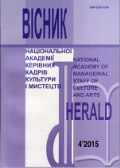A FUNCTIONAL SYSTEM OF MUSICAL-PERFORMING SPEECH
DOI:
https://doi.org/10.32461/2226-3209.4.2015.138432Keywords:
musical performance speech process, text, music and performing language system, music and performing intonational system of means of expressionAbstract
The article is devoted to the systematic functional analysis of creating of the sound text of a musical work in view of the musical performance updating of the musical text. The creative process of updating of the note text, which consists in the study of the functional system of musical-performing speech, viewed in the plane of the verbal paradigms of musical performance. In one of the previous articles the author points out that "... the process of execution of music can be defined as a specific "musical language and speech process" that is associated with the process of thinking of an artist, is realized by the respective musical-performing assets and it is a way of intercommunication between ...". [1, 213].
The systemacy and the functionality are interconnecting many phenomena of the musical art. The study of the process of execution of the music compositions as "the language-speech" process, involves the use of dialectically related method of the system functional analysis.
The category of musical performance "language" and "speech" are the instrumental categories of theoretical
analysis and reflection method of internal and external functional specificity of musical performance speech.
Оn the one hand in the modern musicology there is a need to improve the categorical apparatus of the theory of musical performance, and on the other – comprehension of the musical performance, as language and speech is undeveloped field of theoretical studies. Due to the fact that musical performance language and speech, as well as natural language and speech, are functional systems and become apparent through functional and structural elements. This article defines language and speech units and elements of the mentioned system. As the speech and language resources are considered the components of the musical performance intonation system of means of expression.
The article emphasizes the idea that some of the methodological orientations of linguistics show the best correlation with musical performance views:
• Notes-sound text as a sequence of symbolic units combined by semantic relationships. The main quality of this relationship is integrity;
• The phonological, morphological, lexical and semantic characteristics of the notes-sound text, which is a significantreflection of the structural organization of the composer's language.
• The musical-performing language and speech units have a symbolic nature, as they show all features of
signs. These signs have material expressions, thought content (meaning), and the corresponding meaning. They have
the conditioned connection to the signs of which they are part. Musical performance language as a system-structural
formation is a set of language units and elements. Defining them the author is guided by musicological and linguistic methodologies, taking into consideration the specifics of musical performance.
The article notes that in linguistics, phoneme, morpheme, word, sentence, often defined as linguistic units and the parts that make up these units, are defined as elements of the language system. This corresponds to the specifics of the structuring of musical performing language-speech process, in which the actualization of language and speech units is carried out by elements of intonation means of expression, and they are a way to demonstrate musical-performing speech.
Determination of the structural composition of the functional system of musical-performing speech is realized in the traditional musicology terminology. In this context, language and speech units in their scale-tiered structuring are called: tone – submotiv – motive – phrase – sentence. Intonation and semantic elements that constitute and actualize these units are the elements of intonation of musical-performing means of expression. The author considers that "language and speech" discourse comprehension of musical performance, declared in the article, is relevant for both theory and practice of musical performance.
Downloads
Published
Issue
Section
License
Authors who publish with this journal agree to the following terms:
1. Authors retain copyright and grant the journal right of first publication with the work simultaneously licensed under a Creative Commons Attribution License that allows others to share the work with an acknowledgement of the work's authorship and initial publication in this journal.
2. Authors are able to enter into separate, additional contractual arrangements for the non-exclusive distribution of the journal's published version of the work (e.g., post it to an institutional repository or publish it in a book), with an acknowledgement of its initial publication in this journal.
3. Authors are permitted and encouraged to post their work online (e.g., in institutional repositories or on their website) prior to and during the submission process, as it can lead to productive exchanges, as well as earlier and greater citation of published work (See The Effect of Open Access).


